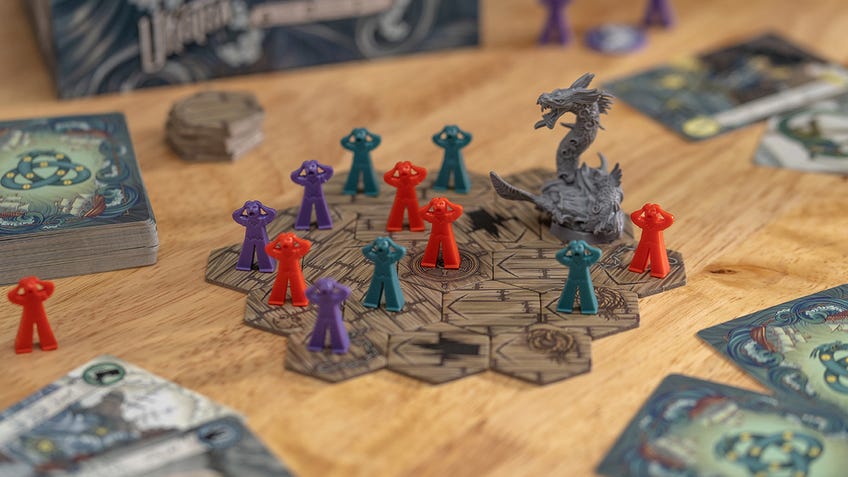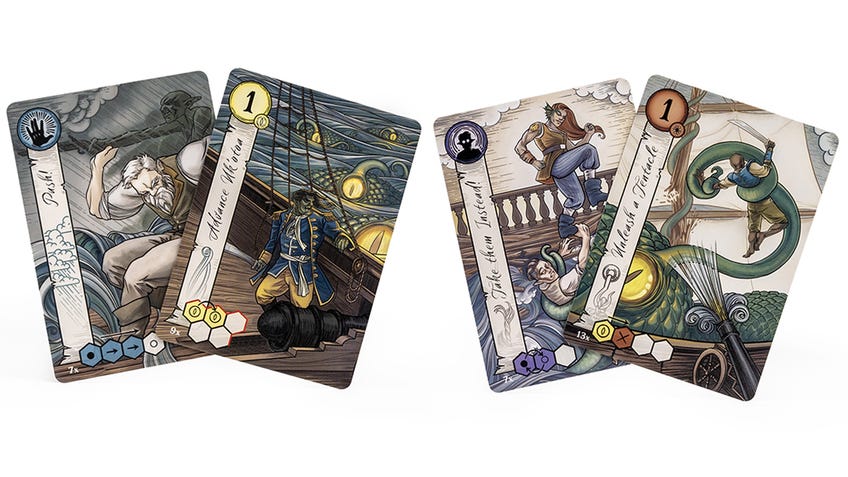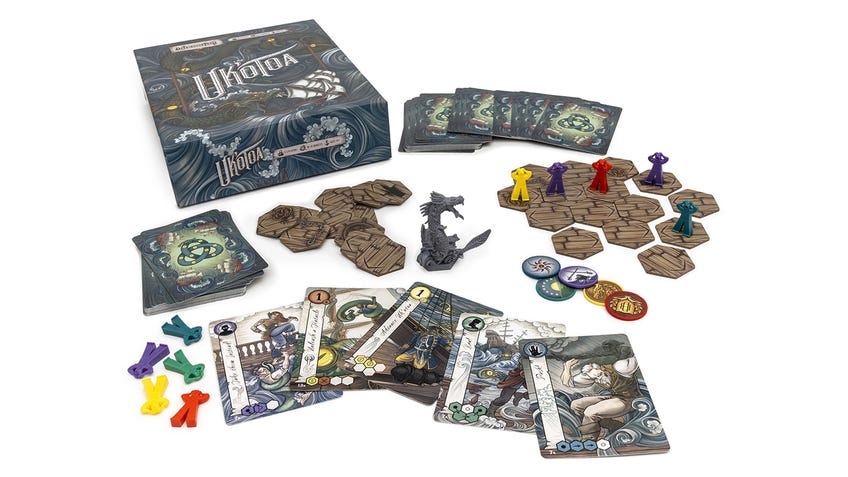Uk’otoa board game review - intriguing but messy debut from Critical Role studio
Eye wish it was better.
Uk’otoa marks the first release from Darrington Press, the publishing company founded last year by Ivan Van Norman - owner of Hunters Entertainment, the studio behind Alice is Missing and the Altered Carbon RPG - with the aim of putting out tabletop titles based on the world of Critical Role. This debut board game is indirectly inspired by the second season of the Dungeons & Dragons actual play show, with players attempting to survive the wrath of the titular one-time antagonist of the Mighty Nein and patron of Fjord.
The fact that the very first title from Darrington Press isn’t more directly adapted from the show seems incredibly strange. Despite the game’s name, parts of its artwork, the sea shanty included on the back - co-written by one of Critical Role’s cast members, Talesin Jaffe - and some referential dialogue on the side of the box, Uk’otoa is an otherwise distant adaptation of Campaign 2. It’s as if the creators wanted to use the licence, but didn’t want to commit to using any recognisable characters or locations. As a result, it ends up feeling like a half-measure rather than a love letter to the world of Wildemount - which already has an absolutely fantastic D&D 5E sourcebook.

At its core, Uk’otoa is a take-that style of board game - meaning that players must attempt to directly inhibit their opponents’ plans - that pairs players into unstable alliances and challenges them to survive a shipwreck and monster attack long enough to win. Players take turns to play cards that result in either Uk’otoa or the sailor meeples controlled by the active player performing an action. Possible actions include moving Uk’otoa, moving one or more meeples, having Uk’otoa attack from a distance, and more. Eventually, player meeples will be eliminated from the game board by the rampaging Uk’otoa until a combination of coloured meeples, or just one colour of meeple, remain.
Uk'otoa ends up feeling like a half-measure rather than a love letter to the world of Wildemount.
On its surface, Uk’otoa is a very simple game in which players perform very simple actions - either moving Uk’otoa or moving the meeples. Dive a little bit deeper, however, and things begin to get unexpectedly complicated. Teams are determined by the colour of the tokens between the players sat at the table. Should either one of these colours be the last ones left on the board, that player wins - either as a team with another player, or on their own. This is meant to encourage players to work together with their respective teammates. However, Uk’otoa is simply too short and player actions are too limited for these alliances to really blossom beyond serving as identification of which meeples players want to protect.
It certainly doesn’t help that the rulebook fails to properly highlight essential pieces of information for first-time players. Setting up the game - which is, once again, complicated in theory but fairly simple in execution - is explained in text and accompanied by an illustration, but it would be massively beneficial to have one or two instructional diagrams alongside that. Fundamental rules - such as the need to remove tiles whenever Uk’otoa moves and the requirement that it move in the direction of the arrows shown on the tiles - are hidden inside paragraphs, when they should be bolded and outlined to make them more visible to readers. Our group had to restart the game three times over because we’d either set it up incorrectly or had played it through incorrectly, making the initial experience of playing Uk’otoa a decidedly frustrating one.
Whenever players reach a point in the game where they each have one or two of their meeples remaining - that’s when Uk’otoa is at its most engaging and exciting.
The game’s components didn’t help with both our understanding and enjoyment of Uk’otoa. The arrows displayed on the tiles should be a much brighter colour to make them easier for players to see, the blue and green meeples are far too similar in colour - making the game more difficult for colourblind individuals to play - and the meeples look like they’re from another game entirely and fall over almost constantly. Though the design of the Uk’otoa miniature is beautifully detailed and evocative, it is far too big compared to the other pieces and has a tendency to knock things over. Which is a shame, as the artwork for the title is really pretty and plays into Critical Role’s recurring motifs of tattoos and eyes.

There’s clearly been some love and care put into Uk’otoa. However, it has its fair share of issues.
Playing Uk’otoa can result in some great moments of tension and fun when players are using their cards to move the sea monster or their own meeples across the board. Forcing players to remove tiles whenever Uk’otoa leaves them is a fantastic way of building up suspense, and can put players in some difficult situations that they’ll need to think their way out of, fast. There are ways of utilising duplicate cards that might otherwise be useless by allowing players to use two or more of them to extend their turn or swap them out for a fresh card from the deck. Whenever players reach a point in the game where they each have one or two of their meeples remaining, and must desperately hope that they can hold on until their or one of their partner’s turns rolls around - that’s when Uk’otoa is at its most engaging and exciting.
Nevertheless, it feels like something has been missed here. What could have otherwise been a small, simple and short game with a recognisable theme and accessible ruleset, instead comes across as a rather messy debut by a publisher that doesn’t feel confident yet. There are kernels of good ideas here and there, and it’s good to see a licensed board game that isn’t just a reskin of an existing title or an obvious cash-grab.
There’s clearly been some love and care put into Uk’otoa. However, it has its fair share of issues that prevent it from being the kind of bold statement Darrington Press might have wanted it to be. Uk’otoa just doesn’t work smoothly or deliver on what it seems to promise. Rather than landing like a triumphant first right hook, it feels more like being slapped by a wet fish.
Uk'otoa is available from the UK and US Critical Role online stores, as well as select local stores.


